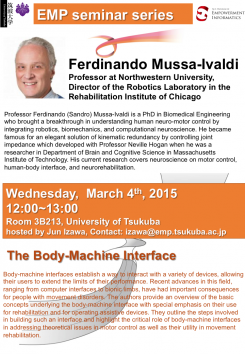The 7th meeting of EMP Seminar Series in Academic Year 2014
Prof. Ferdinando Mussa-Ivaldi, Professor of Physiology, Physical Medicine and Rehabilitation and Biomedical Engineering at Northwestern University and Director of the Rehabilitation Institute of Chicago’s Robotics Lab, will visit the University of Tsukuba and lecture in an EMP seminar. Prof. Mussa-Ivaldi plans to lecture on his thoughts on the subject of “body-machine interfaces” and the latest findings in the field. Don’t miss this valuable opportunity.
Date and Time: March 4th (Wed), 2015, 12:00PM~13:00PM
Room: 3B213, Dai-San Area, University of Tsukuba
Speaker: Professor Ferdinando Mussa-Ivaldi
Professor of Physiology, Physical Medicine and Rehabilitation and Biomedical Engineering at Northwestern University,
Director of the Robotics Laboratory in the Rehabilitation Institute of Chicago
http://www.ric.org/research/centers/smpp/
http://www.ric.org/about/people/doctors/detail/ferdinando-mussa-ivaldi-phd/
Title: The Body-Machine Interface
Abstract:
Since the beginning of the millennium (and well before then) the fancy of lay people, writers and scientists has been captured by the dream of extracting human intentions from neural activities and translating these in commands to robots and other devices. The frontier in brain-machine interfaces now is the establishment of adaptive bi-directional, closed loop interactions between neural and artificial systems, where decoding motor intention is coupled with encoding the state of the external system in patters of stimuli, as a form of artificial proprioception. The promise that so much fascinates the media is the possibility of “controlling by thought.” But is this a biologically and clinically meaningful goal? I will present a different perspective, where the external devices are controlled not by brain activities but by overt motions of the body. In this body/machine interface paradigm many of the encoding/decoding issues are identical to those encountered in the brain/machine communication. But the body-machine interface aims not only at controlling devices, but also at empowering paralyzed people to use their intact body skills, at recovering lost mobility and at developing new forms of motor dexterity.
I will present an overview of four key challenges in the current development of human-machine interfaces based on the reorganization of body motions that remain available to their paralyzed users:
1) The identification of mapping systems for the optimizing the human/machine interactions. In particular, I will describe the use of methods for embedding the space of machine controls within the space of signals generated by body motions.
2) Programming the interface for combining assistive a rehabilitation goals. These are effectively opposing goals. While assistive devices are normally interfaced with their users so as to require minimum control effort, rehabilitation exercises are deigned to encourage engagement in challenging activities.
3) Concurrent human/machine learning for adapting the interface to the improving or degrading skills of their users. The adaptation of a human machine interface is likely to take place in parallel with human learning. How should the machine learning parameters be adapted to the user’s learning dynamics?



